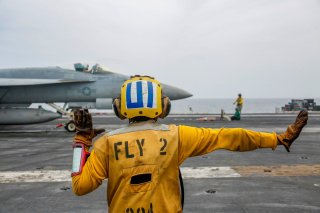Why the Navy's F/A-18 Super Hornet Is Still One Dangerous Fighter
Even if she is a little old.
In February, the United States Navy announced that it would cut production of the legacy F/A-18E/F Super Hornet, to instead accelerate the development of the next-generation carrier-based fighter program. According to the service's newly revealed Fiscal Year 2021 budget request, next year's order of two dozen of the tactical aircraft would be the last in the program. This comes after Super Hornet maker Boeing won a $4-billion multi-year contract to build 78 of the strike attack aircraft through FY 2021.
This would bring to an end the F/A-18 program that began in the 1970s with the development of the McDonnell Douglas designed twin-engine F-18 fighter and attack aircraft. The F/A-18 E/F Super Hornet is the final variants of that original multirole fighter aircraft, and features a 20% larger airframe, 7,000lb. empty weight and 15,000lb. heavier maxim weight than the original Hornet. The Super Hornet can also carry 33% more internal fuel, which can increase its mission range by 41% and its endurance by 50% over the earlier aircraft. Moreover, despite the increase in size, the F/A-18E/F actually has 42% fewer parts than its predecessor the F/A-18C/D.
The F/A-18 E/F Super Hornet, which is now manufactured by Boeing following its merger with McDonnell Douglas in 1997, is produced as two distinct versions. The single-seat F/A-18/E and the dual-seat F/A-18/F.
It also has a multirole fighter that can serve as an attack aircraft via the use of different external equipment, as well as its advanced networking capabilities, which allow it to accomplish very specific missions. In this way it is seen as a "force multiplier" that allows it to be deployed to meet the various challenges that a carrier might face. In its fighter mode, it can serve as an escort and provide fleet air defenses from enemy aircraft and other threats, while in its attack mode it can provide force projection, interdiction and close and deep air support.
The Super Hornet has 11 weapons stations, including two wing store stations, and it is able to fulfill a range of armaments that include AIM-9 Sidewinder, AIM-7 Sparrow and AIM-120 AMRAAM air-to-air missiles, guided air-to-ground weapons such as Harpoon, SLAM/SLAM-ER, GBU-10, GBU-51, HARM and Maverick; and free-fall air-to-ground bombs, Mk-76, BDU-48, Mk-82LD, Mk-82HD and Mk-84. The aircraft is also equipped with a General Dynamics M61A2 20mm Gatling-style gun, a hydraulically driven, six-barreled, rotary action, air-cooled, electrically fired weapon that offers selectable rates of either 4,000 or 6,000 rounds per minute.
The first operational use of the F/A-18/E was with Strike Fighter Squadron 115 (VFA-115), known as the "Eagles," which was operating from the USS Abraham Lincoln (CVN 72) on July 24, 2002, and the aircraft saw it first combat action on November 6 of the same year when the squadron took part in hostile targets in the "no-fly" zone in Iraq. The F/A-18E/F was also used deployed as part of Operation Iraqi Freedom in March 2003.
Despite the Navy's decision to stop further production of the F/A-18E/F Super Hornet, it will remain the primary strike power from U.S. carriers for the next decade.
Peter Suciu is a Michigan-based writer who has contributed to more than four dozen magazines, newspapers and websites. He is the author of several books on military headgear including "A Gallery of Military Headdress," which is available on Amazon.com.

